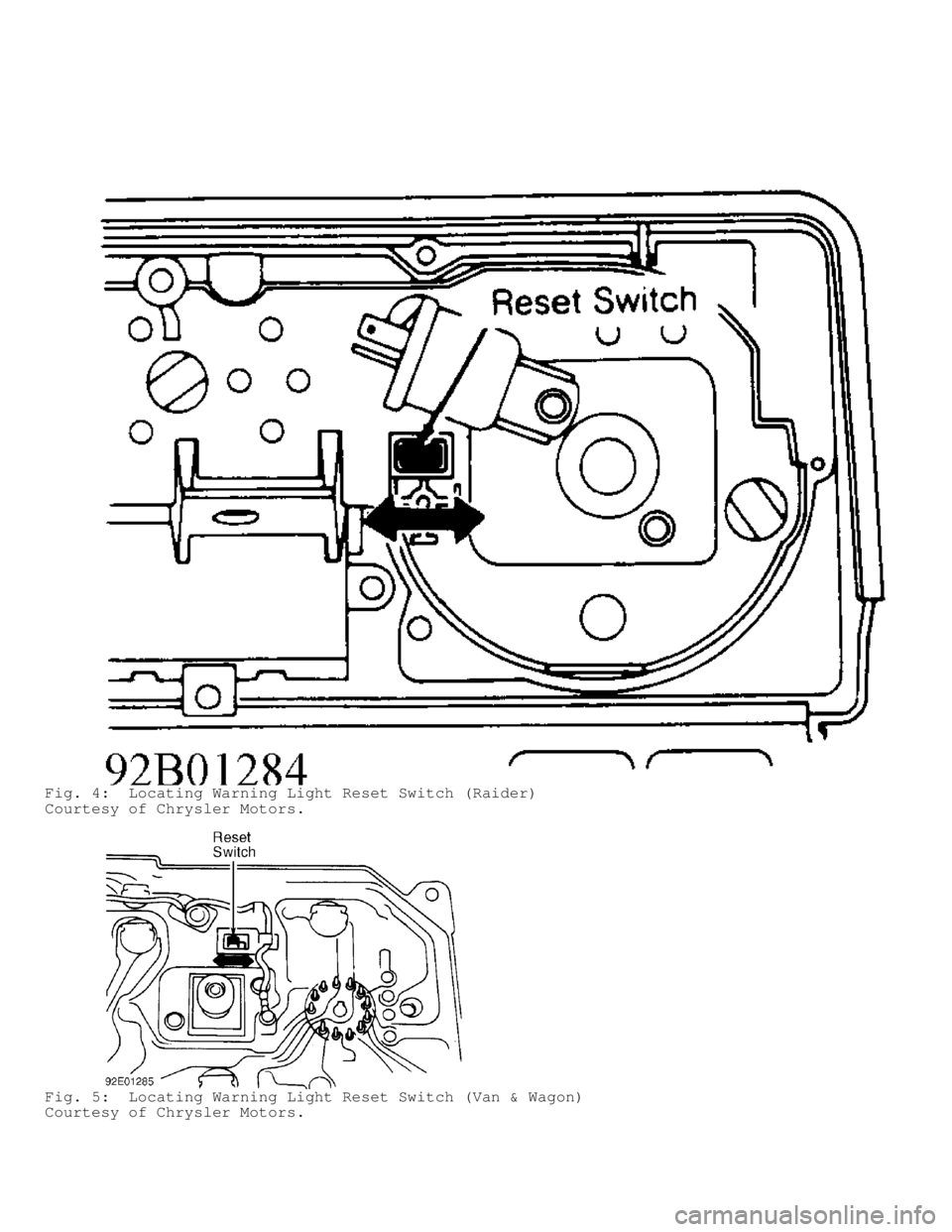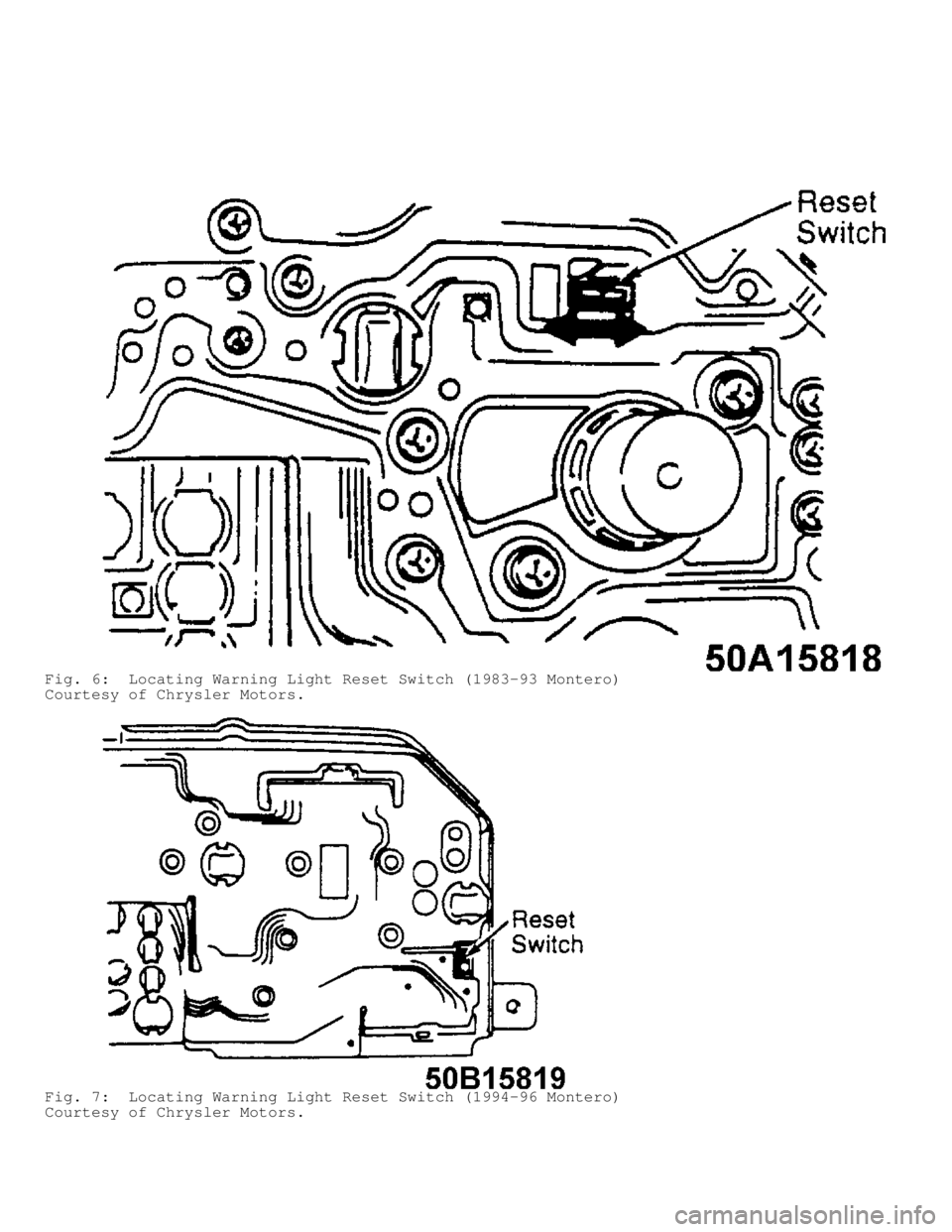1991 MITSUBISHI MONTERO reset
[x] Cancel search: resetPage 678 of 1333

Fig. 4: Locating Warning Light Reset Switch (Raider)
Courtesy of Chrysler Motors.
Fig. 5: Locating Warning Light Reset Switch (Van & Wagon)
Courtesy of Chrysler Motors.
Page 679 of 1333

Fig. 6: Locating Warning Light Reset Switch (1983-93 Montero)
Courtesy of Chrysler Motors.
Fig. 7: Locating Warning Light Reset Switch (1994-96 Montero)
Courtesy of Chrysler Motors.
Page 732 of 1333

Light comes on with the ignition switch in the "ON" position
as a bulb check, but should go out shortly after engine is started. If
light remains on or comes on while driving, it indicates low oil
pressure and possible system malfunction. Have the system checked and
serviced immediately. Do not operate vehicle until cause is located
and corrected.
ALTERNATOR WARNING LIGHT
Light comes on with the ignition switch in the "ON" position
as a bulb check and goes out after engine is started. If light remains
on or comes on while driving, it indicates possible fault in the
electrical charging system. The alternator belt may be loose or
broken. Have the system checked and serviced promptly. Do not drive
vehicle if alternator belt is loose or broken.
"BRAKE" WARNING LIGHT
Light comes on with the ignition switch in the "ON" position
as a bulb check and goes out after engine is started. Light will also
come on with the parking brake fully or partially engaged. If light
remains on or comes on at any other time, it indicates low brake fluid
level in the master cylinder reservoir or the parking brake switch may
be damaged. Have the system checked and serviced immediately if brake
fluid level is low. Do not continue driving if further trouble is
experienced.
"CHECK ENGINE" WARNING LIGHT (IF EQUIPPED)
Light is designed to come on briefly with the ignition switch
in the "ON" position as a bulb check. If light remains on or comes on
while driving, it indicates fault in an exhaust gas related component
and the system is not functioning properly. Have the system checked
and serviced as soon as possible.
"MAINTENANCE REQUIRED" WARNING LIGHT (IF EQUIPPED)
Light comes on at 50,000 miles, 80,000 miles, 100,000 miles
and 120,000 miles (150,000 miles on 1990-91 models) as a service
reminder that it is time for the periodic maintenance of the emission
control system. Have the system inspected and serviced as necessary
when light comes on. Continued operation of vehicle without having
system serviced after warning light comes on may adversely affect
proper performance of the emission control system. Reset warning
light, after the system has been checked, by pushing the reset switch
in front of the combination meter. Remove the warning light bulb after
the last maintenance service at 120,000 miles (150,000 miles on 1990-
91 models).
"A/T TEMPERATURE" WARNING LIGHT (IF EQUIPPED)
Light comes on when the automatic transmission fluid
temperature becomes abnormally high. If light comes on, reduce engine
speed, stop car and put it in "P" (Park) position. Leave engine
running until light goes out. Normal vehicle operation may be resumed
after light has gone out. If light does not go out, have the system
checked and serviced as necessary.
WHEEL LOCK INDICATOR LIGHT (IF EQUIPPED)
Light comes on when automatic free-wheeling hubs are locked.
If ignition is turned off, indicator light will not come on when
Page 874 of 1333

PROCEDURE chart after repairs. Ensure charts apply to engine
being tested.
DRB-II KEY FUNCTIONS
* YES or Down Arrow & NO or Up Arrow
Keys will move lines on screen up or down allowing you to
choose an item or scroll through all selections
available.
* F1 & F2 Keys
Keys are used to scroll through sensor displays.
* ATM Key
Key will return you to previous screen.
* ENTER Key
Allows you to select a test or display. The flashing
arrow must be on the display you wish to select. Pressing
ENTER in the sensor state will cause display to change
from a 3-line display to a 1-line display.
* F3 Key
Key is used to display a help screen. This key may be
used at any time.
* Number Keys
Keys are used for choosing a display or test by the
number for the test or display.
* READ/HOLD Key
Key is used to freeze any sensor display.
* MODE & ATM Key
Pressing MODE and ATM key at the same time will cause
DRB-II to reset to copyright screen.
ENTERING ON-BOARD DIAGNOSTICS (USING DRB-II)
* PLEASE READ THIS FIRST *
1) Before entering on-board diagnostics, refer to PRETEST
INSPECTION in this article. Turn ignition off. Locate self-diagnostic
connector. See SELF-DIAGNOSTIC TEST CONNECTOR LOCATION table in this
article. Using appropriate Mitsubishi cartridge and adapter, connect
DRB-II to diagnostic connector.
2) Ensure all accessories are off. Turn ignition on. All
character positions will illuminate and copyright information will
appear on screen for a few seconds.
3) If DRB-II screen displays an error message, refer to DRB-
II ERROR SCREENS in this article. The DRB-II will offer 4 menus:
VEHICLES TESTED, HOW TO USE, CONFIGURE and SELECT VEHICLE.
VEHICLES TESTED
Press "1" key or ENTER key when VEHICLES TESTED appears on
DRB-II. DRB-II shows models covered by cartridge. Screen will display
for 5 seconds and return to DRB-II menu. To return to DRB-II menu
sooner, press ATM key.
HOW TO USE
Press "2" key or press down arrow to display HOW TO USE
option and press ENTER. Press and hold F3 key. DRB-II displays
instructions for cartridge usage. To return to DRB-II menu, press ATM
key.
CONFIGURE
Page 875 of 1333

Press "3" key or press down arrow to display CONFIGURE option
and press ENTER. Configure allows user to customize DRB-II display.
For example, If metric system is more useful, select METRIC from the
menu. All selections in CONFIGURE option remain active until user
changes selection.
SELECT VEHICLE
1) This allows the user to enter information about vehicle
being tested. Usually, this option has more than one display screen.
Use ENTER key to enter vehicle information.
2) When all information about vehicle is entered, DRB-II will
display an information summary the technician has entered. DRB-II will
show an additional option marked CONFIRM. If information is correct,
press CONFIRM. DRB-II will display MAIN MENU.
MAIN MENU
The MAIN MENU represents all diagnostic functions available.
Functions are SYSTEM TESTS, READ FAULTS, STATE DISPLAYS, ACTUATOR
TESTS and ADJUSTMENTS. SYSTEM TESTS is NOT available.
READ FAULTS
This allows technician to read fault codes stored in ECU
memory.
STATE DISPLAYS
1) This allows technician to view conditions at signal level.
The 2 types of signals are analog and digital. Analog signals are
monitored at pins corresponding to vehicle harness splices (e.g. fuel
pump relay).
2) Digital signals correspond to data transmitted by the
system controllers. Both signals are displayed in common units (e.g.
temperature). Use up and down arrow keys on DRB-II to scroll through
displays available.
3) The following ENGINE state displays are available on DRB-
II:
* Module Information - This mode allows technician to read ECU
part number and application.
* Engine Sensors - This mode allows technician to look at
various engine sensors during engine operation.
* Inputs/Outputs - This mode allows technician to read input
and output states of various switches and sensors.
* Custom Display - This screen allows technician to set up
his/her own custom display. Two custom display screens can be
programmed into DRB-II.
* Minimum/Current/Maximum - The MIN/CURRENT/MAX display shows a
history of conditions for a specific sensor. When this option
is selected, maximum, current (static) and minimum values can\
be displayed for a specific sensor. To reset sensors to a
zero value, simply press ENTER key. This display may be used
to isolate intermittent faults. The MIN/CURRENT/MAX display
allows technician to observe operation of 6 different sensor
values. Information is displayed as a 3-digit number. The
first value displayed is the minimum reading, the second
number is the current reading and third valve is the maximum
reading. Typically sensors range between 2-252. Values less
than 2 or greater than 252 will usually indicate that a
Page 1145 of 1333

See FUEL DELIVERY under FUEL SYSTEM.
Idle Speed Control Servo
See IDLE SPEED under FUEL SYSTEM.
Power Transistor(s) & Ignition Coils
See IGNITION SYSTEMS.
Purge Control Solenoid Valve
See EVAPORATIVE CONTROL under EMISSION SYSTEMS.
Self-Diagnostic Connector
See SELF-DIAGNOSTIC SYSTEM.
Wastegate Control Solenoid Valve
See TURBOCHARGED ENGINES under AIR INDUCTION SYSTEM.
FUEL SYSTEM
FUEL DELIVERY
Electric fuel pump (located in gas tank) feeds fuel through
in-tank fuel filter, external fuel filter (located in engine
compartment) and fuel injector rail.
Fuel Pump
Consists of an impeller driven by a motor. Pump has an
internal check valve to maintain system pressure and a relief valve to
protect the fuel pressure circuit. Pump receives voltage supply from
Multi-Point Injection (MPI) control relay.
Fuel Pressure Control Solenoid Valve (Turbo Only)
Prevents rough idle due to fuel percolation. On engine
restart, if engine coolant or intake air temperatures reach a preset
value, ECU applies voltage to fuel pressure control solenoid valve for
2 minutes after engine re-start. Valve opens, allowing atmospheric
pressure to be applied to fuel pressure regulator diaphragm. This
allows maximum available fuel pressure at injectors, enriching fuel
mixture and maintaining stable idle at high engine temperatures.
Fuel Pressure Regulator
Located on fuel injector rail, this diaphragm-operated relief
valve adjusts fuel pressure according to engine manifold vacuum.
As engine manifold vacuum increases (closed throttle), fuel
pressure regulator diaphragm opens relief valve, allowing pressure to
bleed off through fuel return line, reducing fuel pressure.
As engine manifold vacuum decreases (open throttle), fuel
pressure regulator diaphragm closes valve, preventing pressure from
bleeding off through fuel return line, increasing fuel pressure.
FUEL CONTROL
Fuel Injectors
Fuel is supplied to engine through electronically pulsed
(timed) injector valves located on fuel rail(s). ECU controls amount\
of fuel metered through injectors based upon information received from
sensors.
IDLE SPEED
Air Conditioner Relay
When A/C is turned on with engine at idle, ECU signals ISC
Page 1146 of 1333

motor to increase idle speed. To prevent A/C compressor from switching
on before idle speed has increased, ECU momentarily opens A/C relay
circuit.
Idle Speed Control (ISC) Motor
Controls pintle-type air valve (DOHC engines) or throttle
plate angle (SOHC engines) to regulate volume of intake air at idle.
During start mode, ECU controls idle intake air volume
according to coolant temperature input. After starting, with idle
position switch activated (throttle closed), fast idle speed is
controlled by ISC motor and fast idle air control valve (if equipped).\
When idle switch is deactivated (throttle open), ISC motor
moves to a preset position in accordance with coolant temperature
input.
When automatic transmission (if equipped) is shifted from
Neutral to Drive, A/C is turned on or power steering pressure reaches
a preset value, ECU signals ISC motor to increase engine RPM.
Fast Idle Air Control Valve
Some models use a coolant temperature-sensitive fast idle air
control valve, located on throttle body, to admit additional intake
air volume during engine warm-up. Control valve closes as temperature
increases, restricting by-pass airflow rate. At engine warm-up, valve
closes completely.
IGNITION SYSTEMS
DIRECT IGNITION SYSTEM (DIS) - DOHC ENGINES
Ignition system is a 2-coil, distributorless ignition system.
Crankshaft angle and TDC sensor assembly, mounted in place of
distributor, are optically controlled.
Power Transistors & Ignition Coils
Based on crankshaft angle and TDC sensor inputs, ECU controls
timing and directly activates each power transistor to fire coils.
Power transistor "A" controls primary current of ignition coil "A" to
fire spark plugs on cylinders No. 1 and 4 at the same time. Power
transistor "B" controls primary current of ignition coil "B" to fire
spark plugs on cylinders No. 2 and 3 at the same time.
Although each coil fires 2 plugs at the same time, ignition
takes place in only one cylinder since the other cylinder is on its
exhaust stroke when plug fires.
ELECTRONIC IGNITION SYSTEM - SOHC ENGINES
Mitsubishi breakerless electronic ignition system uses a disc
and optical sensing unit to trigger power transistor.
Power Transistor & Ignition Coil
Power transistor is mounted inside distributor with disc and
optical sensing unit. When ignition is on, ignition coil primary
circuit is energized. As distributor shaft rotates, disc rotates,
triggering optical sensing unit. ECU receives signals from optical
sensing unit. Signals are converted and sent to power transistor,
interrupting primary current flow and inducing secondary voltage.
IGNITION TIMING CONTROL SYSTEM
Ignition timing is controlled by ECU. ECU adjusts timing
based upon various conditions, such as engine temperature, altitude
and detonation (turbo vehicles only).
Page 1147 of 1333

EMISSION SYSTEMS
EXHAUST GAS RECIRCULATION (EGR) CONTROL
Federal (Non-Turbocharged)
To lower oxides of nitrogen (NOx) exhaust emissions, a non-
computer controlled exhaust gas recirculation system is used. EGR
operation is controlled by throttle body ported vacuum. Vacuum is
routed through thermovalve to prevent EGR operation at low engine
temperatures.
Spring pressure holds EGR valve closed during low vacuum
conditions (engine idling or wide open throttle). When vacuum pressure\
increases and overcomes EGR spring pressure, EGR valve is lifted and
allows exhaust gases to flow into intake manifold for combustion.
California & Turbocharged
ECU controls EGR operation by activating EGR control solenoid
valve according to engine load. When engine is cold, ECU signals EGR
control solenoid valve to deactivate EGR.
California models are equipped with an EGR temperature
sensor. When EGR malfunction occurs, EGR temperature decreases and ECU
illuminates CHECK ENGINE (malfunction indicator) light.
EGR Control Solenoid Valve
Denies or allows vacuum supply to EGR valve, based upon ECU
commands.
Thermovalve
Denies or allows vacuum supply to EGR valve based on coolant
temperature.
EVAPORATIVE CONTROL
Fuel evaporation system prevents fuel vapor from entering
atmosphere. System consists of a special fuel tank with vapor
separator tanks (if equipped), vacuum relief filler cap, overfill
limiter (2-way valve), fuel check valve, thermovalve (if equipped),
charcoal canister, purge control valve, purge control solenoid valve
and connecting lines and hoses.
Purge Control Solenoid Valve
When engine is off, fuel vapors are vented into charcoal
canister. When engine is warmed to normal operating temperature and
running above idle, ECU energizes purge control solenoid valve,
allowing vacuum to purge valve.
Canister vapors are then drawn through purge valve into
intake manifold for burning. Purge control solenoid valve remains
closed during idle and engine warm-up to reduce HC and CO emissions.
HIGH ALTITUDE CONTROL (HAC)
This system compensates for variations in altitude. When
atmospheric (barometric) pressure sensor determines vehicle is above
preset altitude, ECU compensates by adjusting air/fuel mixture and
ignition timing. If HAC system is inoperative, there will be an
increase in emissions.
PCV VALVE
Positive Crankcase Ventilation (PCV) valve operates in the
closed crankcase ventilation system. Closed crankcase ventilation